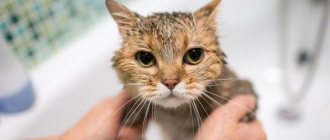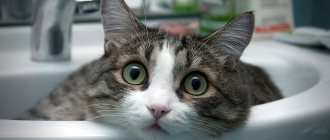At some point, cat owners need to wash their four-legged friend. And here a reasonable question arises about how to bathe a cat and “stay alive.” It is known that mustachioed and striped purrs do not like water procedures, and some of them simply cannot stand them. When washing, even the most affectionate pet sometimes turns into an angry predator that can seriously scratch you. By nature, cats are very cautious and will never get into the water unless absolutely necessary. How to bathe a cat if it gets dirty? How to reduce the unpleasant experience of the process so that the cat does not worry? This article answers these and other questions.
Is it necessary to do this at all?
Some owners argue as follows: since cats themselves are very clean, it is not at all necessary to subject them to the enormous stress that is bathing at home. This opinion is wrong. How to properly bathe a cat can only be learned by approaching this issue with all responsibility. It must be said that it is necessary to wash cats for the reason that dust and dirt gradually accumulate on their fur, which cannot be cleaned out with a rough tongue. Cats are real clean people, and therefore they will lick themselves endlessly, trying at all costs to get rid of any dirt. This excessive littering can lead to a large accumulation of cat hair in the stomach and cause a number of diseases.
You should wash your cat no more than once or twice every six months. Of course, a lot will depend on what kind of coat she has. If a cat wears a luxurious fur coat, then he will have to be bathed more often. Grooming is especially necessary for show animals before important events. In other cases, you need to wash your purr as needed.
When does a cat need a bath?
Many people believe that cats are good at maintaining their personal hygiene on their own because they spend a lot of time licking their fur. It’s really not worth washing your cat every week just to keep its fur smooth and silky. Cat fur is covered with a special lubricant produced by the sebaceous glands. Bathing with shampoo washes away this lubricant, and the natural protection disappears.
Pollution
If the animal is dirty and the contaminated area is large enough, you will have to carry out a bath procedure. Cats love to explore everything around them and can find adventures in their fur - without even leaving the apartment.
Minor dirt can be wiped off with a napkin or a damp cloth - and without washing. Also, do not expose your pet to stress after walks - just wipe his paws if he steps in a puddle.
Before the exhibition
In order for the jury to appreciate your pet, it should be brought into appropriate shape. Usually the cat is taken to a grooming salon, where a specialist does a complete “maraffe”, but some owners cope with this task themselves.
An exhibition animal must be accustomed to complex hygienic procedures from childhood. Otherwise, it will be very difficult to bring it into a decent appearance.
Washing before a show should include cleansing the coat, applying balms, conditioners, oils and powders. Afterwards - thorough combing.
Scheduled cleanliness
The dirt that you bring into the house on your shoes remains in your pet’s undercoat, and by licking it, the cat can harm its body. Therefore, preventive bathing is still necessary.
If your pet is not noticeably dirty, you can wash it no more than several times a year.
Therapeutic bathing (against parasites)
After the cat has been treated for ticks and fleas, it needs to be washed - unless there are contraindications in the instructions included with the drug. Another option is to use insecticidal shampoos. They are a good protection against fleas in cases where the cat accepts bath procedures normally.
When to accustom a cat to water procedures?
How to bathe a cat? It is extremely important to “introduce” a cat to the bathroom at a young age. There is an opinion that if the kitten is not accustomed to regular washing in time, then later you will not be able to do this. Representatives of the cat breed are very sensitive to their habits, so you need to make sure that they are formed in advance. The little kitten will look to you for protection, and most likely will perceive washing as something inevitable. An adult animal will definitely release its claws in the event of such an unforeseen circumstance and may inadvertently inflict deep scratches on the owner.
Preparing for the bathing process
Of course, the easiest way is to accustom your pet to water procedures from childhood, from three months. First, the fur should be wiped with a damp, very soft cloth, making sure that the pet likes this procedure. Then gradually immerse it in a bowl of comfortable warm water for a while.
Before the procedure, it is better to trim the nails and comb the fur. There is no need to turn on the water suddenly. Fill the bathtub or basin with water at room temperature, never hot.
It is important to prepare your favorite toys and use them when bathing your pet. Some experts advise keeping food nearby and giving treats if the cat suddenly becomes agitated.
Shampoo, a couple of dry towels, and an anti-slip mat for the bathroom must be prepared in advance. Often a cat is afraid of streams of water pouring from a tap or watering can. In this case, you should not test his patience and fill the bath in advance.
If there is a need to wash a cardinal alarmist, the owner should take care of his own safety. Some breeders use thick gloves that cannot be bitten or scratched. It is also recommended to wear comfortable clothing.
How to behave while swimming?
Try to calm your pet before washing. Say kind words to him (cats are very good at picking up and perceiving a person’s intonation and feeling his mood), pet him, repeat that this is a necessary procedure because he has gotten dirty. It would be a misconception to believe that cats are not capable of deep feelings for their owner. Almost always, these cute fluffies are so attuned to a person that they are able to have a beneficial effect on him.
During the process itself, hold the animal firmly, but not too tightly, with one hand, and carry out the washing procedure directly with the other. How to bathe a cat without consequences? First of all, you must be confident in yourself. Calm your pet if the situation requires it, and, if possible, try to perform all the necessary manipulations as soon as possible. Not a single cat will tolerate such “mockery” for long. It’s better to keep it to 5-10 minutes; you don’t need to count on more.
What to use during washing?
Choosing a shampoo is the most important step in preparing your pet for a bath. If you ask your veterinarian whether you can wash your cat with regular shampoo, you will get a negative answer.
For many, this seems strange, and they do not see the difference between conventional and specialized products. It is best to choose a shampoo designed for cats for the following reasons:
- Human skin and hair differ from wool not only in structure, but also in acidity. Washing cats with regular shampoo can lead to dandruff and deterioration of the coat, as well as skin diseases.
- Human products have strong scented fragrances. Since animals have a very good sense of smell, such fragrances will only harm them and scare them away.
Bath accessories
Before washing, do not forget to prepare everything you need so that your cat does not get scared. Remember: it will not stay in the water for long, so it is extremely important that you have everything at hand. How to bathe a cat and what should be prepared? Shampoo (it should already be on the table next to the bathroom), a soft brush for combing the coat, a special towel for drying, perhaps a small basin or bath.
Many cat owners prefer to wash their pets in small containers, believing that this way they will experience less stress. In fact, a lot depends on your mood. There is no need to buy a baby bathtub. How to bathe a cat if he stubbornly refuses to stand in the container prepared for him? Act gently, be patient and affectionate.
Preparation is an important step
You need to accustom cats to bathing from childhood - about a couple of weeks after you bring your pet home, so that by this time it has already become accustomed to your apartment. When it gets dirty, wipe the cat's fur with a damp cloth so that the cat gets used to the water gradually.
Do not change the place of bathing: if for the first time you washed the cat in a basin, then you do not need to start bathing it in the bathroom: for the animal this procedure should be as familiar and familiar as possible.
What to take to the bathroom
The equipment you will need to wash your cat must be prepared in advance:
- shampoo;
- rubber mat for the bottom of the bathroom;
- a towel – or better yet two;
- hairdryer (if the animal is not very afraid of it).
Remove all tubes and objects that the cat can throw off and get scared even more, sponges and washcloths so that she does not cling to them. Place a rubber mat on the bottom of the bathtub or basin to prevent the cat from slipping.
Choosing a Shampoo
The shampoo should be special, adapted for cat skin, from a veterinary pharmacy - your personal shampoo or soap will not work. A cat will definitely lick itself after bathing, and human shampoos can be toxic to it. In addition, shampoos for people contain dyes and perfumed fragrances, to which allergies can occur.
There is a wide selection of cat bathing products on the market, from budget to expensive. The price depends on the brand, type and purpose (cleansing, medicinal, antiparasitic).
Shampoos come in different forms:
- Liquid
- the most common and familiar, appeared the very first. Liquid shampoos have the best cleaning characteristics. The familiar consistency makes bathing more convenient for the owner.
- Dry
- in the form of mousse or powder, which is sprinkled on the animal’s fur and then thoroughly combed out. Dry shampoo will not clean as well as liquid shampoo, but it is suitable for cats that are categorically against water.
- Shampoo sprays
do not require removal, have antistatic properties, so they are ideal for long-haired cats - after this it is much easier to comb your pet. It sprays quite loudly and can scare the animal - this is a significant disadvantage.
Long-haired cats may need a conditioner - you can buy it along with shampoo at a pet store. Don't skimp on cat cosmetics - it is used little by little, but at the same time it protects the health of your pet.
Where to hold the event
Cats are naturally terrified of water, and the question arises: where can I wash a cat so that it gets less stress and doesn’t scratch its owner? If an animal has unpleasant associations with the bathroom, it is better to move the event to another room. To do this you will need a bowl of water. For those who are less timid, a bath is suitable, but it is better to take it in advance.
You can wet and wash off the foam from the cat using a ladle or jug. It is highly undesirable to use a shower, as it makes noise and scares the animal even more. Another way out is to turn the pressure to minimum.
If you find the right approach and gradually accustom the animal to washing, bathing a cat, even if it is afraid of water, will become as easy as brushing or stroking it.
Water temperature
When preparing a bath for your pet, there are several factors to consider. Firstly, the water should not be too hot, otherwise you risk causing your pet burns of varying degrees of intensity. You should not dip your cat in cold water - he may catch a cold and get sick.
How to bathe a cat without any special consequences for it? Place your pet in the water carefully, trying not to scare it. Make sure that water does not get into the ears. It is not necessary to wash the hair, just wet the rest of the hair and gently rinse it with a special shampoo.
What to do after swimming
After bathing, take your pet out and wrap it in a towel. Take it to the previously prepared sheets and begin to gently dry it. As soon as the towel becomes wet, change it to dry and continue the manipulations.
If your cat is comfortable with a hairdryer, you can dry it with it. The speed should be minimal, and the supplied air should be warm, so as not to frighten the pet away.
If the cat scratches and bites
In the event that an animal shows aggression, there is no need to worry while washing, pet it and say a few kind words. In general, it is advisable to start the procedure itself with this. Understand that the animal needs your support. It is known that cats, to put it mildly, do not like to wash themselves, so sometimes they need to be “persuaded” for a long time. If you keep your cat in the bath too long and he starts biting your hand, it's most likely your fault. Not a single representative of the cat breed will calmly stay in the water for half an hour to forty minutes, so keep in mind that time is limited.
If your pet behaves too aggressively (scratches a lot, deliberately bites your fingers, hisses threateningly), it means that its patience limit has been exhausted for today. What to do in this case? This situation occurs extremely rarely, which is why it is dangerous. If this happens, and you can’t do anything to calm the angry animal, then just let it go. Get him out of the bathroom and give him time to calm down. Most often, such precedents occur due to the fault of the owners, who force the animal to stay in the bathroom for a long time. The same case will occur if you pick up a stray cat on the street and try to wash it. After an unsuccessful attempt, take time to analyze the current situation and realize your mistake. Now you will take a more responsible approach to the question of how to bathe your cat.
Some features
A number of cats tolerate the bathing procedure only if they stand in the bathtub or sink not with four paws, but lean on their hind limbs, with their forelimbs placed on the edge of the bathtub.
- If there is a need to restrain or properly secure an animal, this should be done exclusively by the scruff of the neck, but not by the paw or tail.
- A worried pet should be reassured in a gentle tone, stroking the withers.
- If your pet is very nervous, it is better to free him from captivity in the bath and continue the procedures the next day, gradually accustoming him to water.
Take care of your eyes
I mean your own. An angry animal can inadvertently hurt you. Do not bring your face closer to the cat, because at any moment it can make an uncontrolled movement that can cause serious wounds. It is clear that the question of how to bathe a cat is very difficult.
If he is terribly afraid of water, try pouring water into a container first, and only then placing the animal there. The cat may be frightened by the sound of running water, so do not turn it on additionally. If you have a long-haired pet, you should comb it thoroughly before bathing.
Drying the cat
Dry the cat with a towel.
Take a towel and gently cover it to blot away any excess water. Then wrap your cat in a towel and gently rub. When the towel becomes too wet, grab another dry towel. Don't stop until just the towel is wet again.
- - When you blot water on your cat, do it gently, as if you were massaging him. Also try warming up the towels in the dryer first; cats love warm things.
- - Again, monitor the cat’s condition. If she doesn’t like this process, then it’s better not to continue, she’ll dry out on her own))
10 Well-Known Facts That Are Actually Just Common Myths
We finish drying the cat.
Short-haired cats can dry themselves completely in the bathtub as long as they are away from drafts. They will appreciate a heat source (heater or warm air extractor) and a dry towel to sit on.
With long-haired cats, you will need to use a brush and more towels. Long hair is easy to comb when wet, so it is best to brush your pet before it is completely dry.
- — If your cat is not afraid of a hair dryer, use a warm drying setting, but not hot, keep the hair dryer at a distance. Air flow that is too hot can cause burns and injury, please be aware of this.
- - Gently comb your cat's fur to get rid of any knots or matted tufts. This is especially beneficial for long-haired cats.
Reward your cat.
It is necessary. If you want your cat to want to take a bath again, you must give her a positive connection to the process. Give her her favorite treat, catnip or other treats. If your cat associates bathing with getting tasty treats, your cat will not only love bathing, but will even demand an extra bath day!
- - Praise your pet, pet him, tell him how good and wonderful he is, and pay more attention after taking a bath. After all, after such a test, cats feel vulnerable and scared, don’t forget about it, show them how much you love them.
How to bathe a cat that has never been washed
Of course, circumstances in life can be different: you found a stray animal on the street or you simply never washed your cat for one reason or another. The first thing you should prepare for is that a cat can be stubborn for a long time and refuse to wet its lovely paws. It is better not to turn the washing procedure into violence against the animal, but to try to lure him into the bathroom: to make him go there voluntarily. If necessary, you will have to resort to various tricks and tricks. For example, you can turn on the water in the bathroom and try to attract his attention. Despite their dislike for the water element, many cats watch the flowing streams for a long time and with great interest.
How to bathe a cat? Proper bathing, of course, begins with careful preparation. If you still managed to interest the capricious purr, get ready to act gradually. Do not try to immediately pick up the animal in your arms and plunge it into the water, this will only cause a strong attack of resistance in it. To avoid such a protest when the cat enters the bathroom, let him for a while just watch how the water flows freely and easily. You can even draw his attention to the fact that there is a calm, friendly atmosphere around, and no one is going to offend the cat. How to do it? Just talk to the animal in a gentle voice, pet it. At some point you will feel that your pet has entrusted you with his own washing, and then try to carefully but quickly do everything necessary. While bathing, continue to stroke and soothe your pet.
What is the best way to wash cats?
It is not recommended to wash your cat with soap, shower gel or human shampoo, as it is very difficult to wash them off completely, which can cause poisoning. It is important to purchase a special animal grooming product at the pet store, which has a different pH level and properly cleanses the skin and fur of your pet. In addition, special cat shampoo is designed so that the animal can lick it off.
Special products are suitable for washing cats
The first thing to consider when choosing a shampoo is the breed of the animal. For example, for short-haired cats it is better to choose shampoos with surfactants and oils. After washing with these products, your pet’s coat will become glossy, smooth and shiny. But this option is not suitable for Maine Coons, Persians and other long-haired cats, because after bathing the hair will stick together unsightly, turning into sloppy icicles. Special shampoos are designed for fluffies, which contain wheat protein and medicinal plant extracts.
Alternative option
If it is not possible to bathe your cat at the moment, there is another way to make him clean - dry washing. Today you can find special dry shampoos in pet stores and animal departments. The essence of this “washing” is that the owner does not need to subject his pet to an unpleasant procedure. All that is required is to apply a small amount of product to the fur and comb your pet thoroughly. This option is only suitable for those who have short-haired cats.
Thus, a caring owner should approach bathing a cat with all responsibility. It is necessary to understand that the condition of the animal largely depends on your behavior, and there is absolutely no need to make him once again nervous and anxious.
To wash or not to wash: that is the question
Why artificially wash such smart cleaners who do it on their own? Although there are not many reasons, they still exist:
- The cat got very dirty, for example, knocked over a flower pot or a jar of sour cream.
- The owner needs to show his beauty in the best possible light, usually before the exhibition.
- Representatives of particularly long-haired breeds may not be able to cope with the care of a luxurious fur coat on their own. If the fur is matted, then before washing the cat, you need to comb the cat with a special brush and sort out tangles if they are found.
In any case, experts do not recommend washing cats more often than once every three months.
Stage No. 1. Before bathing your cat
Let's be honest, washing mustachioed and tabby animals is not done in a hurry. And although the outcome of the operation cannot be compared with the Battle of Waterloo, you will still need to weigh the position of forces, develop a strategy and prepare something.
Assess your strength
I’ll say right away that not every person can cope with washing even the calmest cat alone. With an assistant, you will cope with this procedure much easier. The assistant will be able to calm and hold the cat while bathing, especially if you are doing this for the first time and do not yet know how to properly bathe a cat at home.
If you have absolutely no one to ask for help, then it is better to immediately contact a groomer or veterinarian. They know the behavioral characteristics of animals well, and they also have the experience and ability to calm a cat if it gets angry.
Choose a place to swim
The first thing you must clearly decide is not only with whom and how to bathe the cat, but also where it is best to do it. I prefer a sink rather than a bathtub because... I don’t like standing bent over for a long time. When bathing a cat in the sink, I stand upright, it is more convenient for me to control and fix the cat. The sink must be large enough, quite deep and must be equipped with a drain and overflow.
For long-haired animals, you will still have to use the bathroom. Another important element that makes it convenient to wash a cat is a special shower head with a water supply button. By pressing it, you let the water flow, and by releasing the button, you turn it off.
This is ideal as everything can be done with one hand. Such devices also have a lock that allows you to supply water without holding the button. Such a shower can be easily found in plumbing stores.
Brush your cat and trim his nails
Before giving your cat a bath, be sure to trim your pet's claws before bathing, this will help you protect yourself from voluntary or involuntary scratches. It is also important to comb the coat and remove all tangles.
Prepare everything you need in advance
You will need a shampoo that is appropriate for the cat's age, coat type, and circumstances (for example, if the cat has fleas). When purchasing detergents, be sure to consult with a specialist in the store. If he couldn’t help you, you can go to the manufacturer’s website.
Also select conditioner and rinse aid according to your coat type. Choose only concentrated products that do not irritate your eyes. In addition, prepare lotions for the ears and eyes, cotton pads and swabs, a hair dryer, combs and brushes. You will definitely need a plastic ladle with a capacity of 1.5–2 liters, as well as many, many soft, moisture-absorbing towels or old sheets.
Prepare yourself: wear clothes to which hair does not stick too much, and on which the cat’s claws cannot easily catch. If you plan to bathe an adult cat in the bathtub, then you will also need two plastic buckets in which you will prepare the cleaning solution.
Two buckets are needed only to save time: while you are washing or “rinsing” the cat in one, water is collected in the other - that’s all. But, in principle, you can get by with just one bucket.
Prepare the water
Water preparation is my biggest secret. Cats do not like it when water pours from a faucet or shower directly on or next to them and rattles noisily against the bathtub. They perceive the flow of water as something living, scary and dangerous.
In such a situation, no matter how hard you try to wash the cat - videos of such unsuccessful attempts can often be seen on the Internet - it will always try to escape. Therefore, we will only use the shower.
If you don’t have the special scent I wrote about, it’s a shame. With it you will save water, it will not flow just like that, plus you will not have to constantly turn the taps to adjust the water to the desired temperature. Well there is no way.
Set up low flowing warm water from a regular shower. The water should be really warm, not cool or hot. Fill the sink (or both buckets in the tub) as completely as possible. Dissolve a small amount of shampoo in water.
Let me remind you that you need to use a concentrated product. A little shampoo is as much as will fit in the palm of your hand. Also, if you wash your cat in the sink, dissolve the shampoo in a jug of water. Add approximately the same amount of shampoo to the jug as you dissolved in the sink, and you will have a very concentrated solution.
A few words about shampoo
The shampoo should be dissolved in water and not applied to the cat’s fur. Many people do exactly this, and this is the main mistake! Some people manage to apply shampoo even to dry fur, but this is a serious mistake. It is necessary to prepare the solution in advance in order to quickly and efficiently rinse all the animal’s fur.
By dissolving shampoo in water, you reduce the time of the washing procedure - that's one thing, improve the quality of washing - that's two, and save shampoo - that's three. By the way, properly diluted shampoo does not produce a lot of foam.
Why are cats afraid of water?
A cat's fear of water is a topic on which an experienced zoopsychologist is ready to discuss for hours. This fear can have so many obvious and hidden reasons (some of which are determined by the pet’s individual life experiences) that it is impossible to list them all. Most often, the root of the problem lies in factors such as:
- Unusual environment. Cats are rather conservative animals that react sharply to changing environmental conditions. If something does not allow the pet to quickly assess new circumstances (for example, due to paws sliding along the bottom of the bathtub and altered gravity, it is difficult for the animal to determine its position in space, and the transparency of the water prevents it from correctly assessing the area occupied by a “wet obstacle”), stress reaches the level of aggressive panic.
- Noise. For reasons of convenience, many owners prefer to wash their pets in the shower, while the sound of streams of water escaping from the watering can horrifies the animals. Cats are generally very nervous about noise, especially if they are unable to understand its nature. It is possible that the unfortunate pet will mistake the vibrating watering can for a living creature, hissing, spitting water and clearly in an aggressive mood. The reaction will be appropriate.
- Restriction of freedom. There is not a single cat who would calmly react to attempts to forcibly keep him in place, especially in an unpleasant environment.
- Smell. Having a keen sense of smell, cats cannot stand the “aroma” of wet fur, especially if it comes from themselves. Once faced with the problem of an unbearable odor after a bath, the pet will most likely prefer to avoid water procedures in the future.
- Overheating or hypothermia. When drawing a bath, most owners are guided by their own ideas about a comfortable water temperature. This is mistake. We must not forget that the normal body temperature of a cat differs from that of a human and is 37–39°C. Accordingly, the animal should be bathed in water heated to a pleasant 40°C, and nothing else. If your pet has previously been forced to take a bath that is too cold or too hot, he is unlikely to want to repeat this experience.











